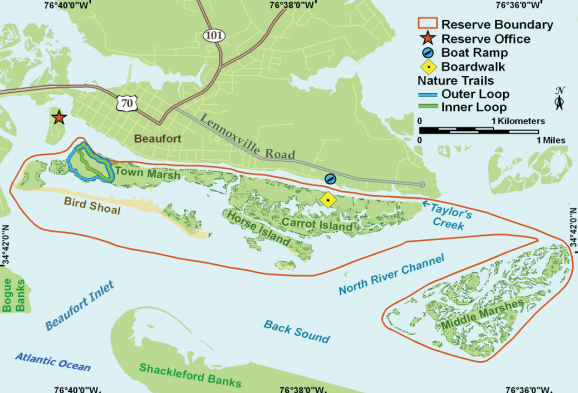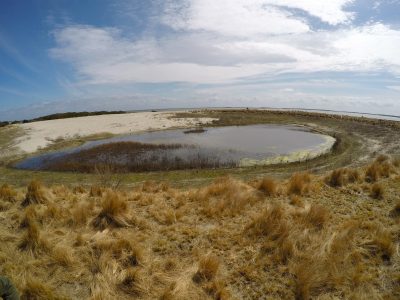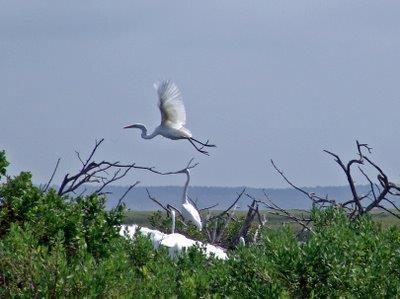BEAUFORT — Hunting has been allowed at the Rachel Carson Reserve since it was established in the 1980s, but increasing numbers of year-round recreational and educational visitors to the reserve’s five islands have prompted safety concerns and a move to put restrictions on hunting.
Officials with the North Carolina Coastal Reserve and National Estuarine Research Reserve held a meeting March 9 at the Beaufort Train Depot to hear input from the public about the possibility of imposing a hunting permit system. At issue are the areas outside of town limits where hunting is approved: the east end of Carrot Island and Middle Marsh. On the table is a plan to limit hunting, now allowed Monday-Saturday during the season, to only Tuesdays and Saturdays. The idea for the east end of Carrot Island is to grant permits for up to six individuals, or two parties of three persons, per day on the designated days at a cost of $5 each. On Middle Marsh, the $5 permit would be for the entire hunting season.
Supporter Spotlight

“When the Rachel Carson Reserve was designated in the early ’80s, there was hardly any development near the east end of the island, where you didn’t even notice there was hunting,” said Paula Gillikin, central sites manager for Rachel Carson and Permuda Island reserves.
Tourism has increased across the county almost two-fold since 1991. This surge is causing conflicts among groups engaging in different activities on Carrot Island, such as photographers, kayakers and paddlers who frequent areas traditionally used by hunters.
“A whole suite of things has changed since the site was designated. We hardly had complaints when the reserve was designated, but in the past 10 years, I have received more complaints about these particular issues,” Gillikin said.
What is the Rachel Carson Reserve?
The Rachel Carson Reserve encompasses an area between the mouths of the Newport and North rivers, across from the Beaufort waterfront. The main site includes Carrot Island, Town Marsh, Bird Shoal and Horse Island. These islands total more than 3 miles in length and are narrower than a mile wide. Middle Marsh is separated by the North River Channel and is almost 2 miles long and less than a mile wide. Acquisition of the area was finalized in 1985, with the addition of Middle Marsh in 1989.
Preservation allows this coastal ecosystem to be available as a natural outdoor laboratory where scientists, students and the public can learn about coastal processes, functions and the influences that shape and sustain the coastal area. Traditional recreational uses are allowed, if they do not disturb the environment or organisms or interfere with research and educational activities.
Supporter Spotlight
With that in mind, it may be easier to understand why many are surprised hunting is permitted on the reserve.
Gillikin explained that in addition to protecting representative coastal North Carolina ecosystems, enabling research to inform sound management of coastal resources and increasing understanding of their importance and the effects humans have on them, the reserve serves to accommodate compatible, traditional recreational uses.

“The last point is related to hunting. Hunting is specifically called out as a traditional use,” Gillikin said. “When the North Carolina Coastal Reserve and National Estuarine Research Reserve was established in the early ’80s, the state had an agreement that the reserve would maintain these traditional uses, such as hiking, birdwatching, any number of activities that had been done on the site already.”
Gillikin presented during the meeting a list of complaints received regarding hunting on Carrot Island – the area where hunting is allowed is only about 500 acres. These complaints included the presence of spent shotgun shells and debris, evidence of possible baiting and reports of personal property left behind. Also expressed were concerns about visitor safety and enjoyment, hunting inside town limits where nearby residents can hear shooting from their houses and the safety of the wild horses that populate the reserve.
“To address some of the imbalance of user groups and the changes that occur, instead of completely prohibiting hunting, which would be a hard thing to do and we really are trying to preserve traditional hunting opportunities, we are going to put some restrictions on it through a permitting system to try to address some issues,” Gillikin continued. “We are going to do it through a specific timing, a limit on the number of people, and we are also talking about prohibiting lead shot on the reserve, because lead can be detrimental on the estuarine ecosystems to different marsh species and the environment in general.”
Tommy Hughes, coastal ecoregion supervisor with the North Carolina Wildlife Resources Commission, was also at the meeting to help answer questions about the proposed permit system.
“There will be two hunting units: one on the east end of Carrot Island and one on Middle Marsh,: Hughes said. “On the east end of Carrot Island, there needs to be a restriction on the number of people who are hunting.”
Primarily hunted species include dove, rail, waterfowl and rabbit.
The permit system will restrict the days hunters can be there and what species they may target. “This limits the number of people on the east end of Carrot Island,” Hughes said.

“On Middle Marsh, we’re looking at things a little different,” he continued. “Because you’re not having problems out on Middle Marsh, you can get a permit for webless migratory game birds and waterfowl. There would still be a steel-shot restriction but anybody could get that permit; there are no limits to the numbers. The only thing that will affect anyone now is that there is a $5 charge for the permit.”
The permit system gives the Wildlife Resources Commission an opportunity to create a database with addresses and information on the hunters that can be used by both the commission and the reserve personnel. This information has not been available before.
Gillikin said a wealth of information on users of the reserve had been available, but not on hunters.
Pam Valente, a volunteer at the Rachel Carson Reserve, was the only meeting attendee who chose to speak. Valente began by saying that she is glad to hear there will be more restricted hunting on the east end of Carrot Island.
“Never in my wildest imagination in the ‘70s and ‘80s did I think people would be making a living taking tourists to that island,” Valente said. “So, it’s astounding to me how many people go over there. I think hunting in that area, it’s just inherently dangerous for people. I don’t think it should be happening at all, so anything you can do to cut back on it is a good thing. Besides the people, the fact is that it’s a nature reserve, it’s a place for nature.
Hunting is simply not compatible with the changes that have happened on that island, Valente continued. “It seems to me that the very little bit of hunting that can be done there can be done somewhere else. And it would be a lot safer for people and a lot more contentious for the wildlife.”
Gillikin said after the public comment portion of the meeting that management practices must adapt to the changing uses of the reserve.
“It is our responsibility to balance and understand the extent of a multitude of traditional uses, including hunting, and that is what we are aiming to accomplish through the permit system,” she said.
Information on the hunting permit system is to be posted on Wildlife Resources Commission’s website prior to the start of the fall 2017 hunting season.
Hughes said the next step involves approval by the North Carolina Division of Coastal Management, or DCM.
“Once we hear back from DCM to proceed, we will incorporate this into our Permit Hunt Opportunities Program,” Hughes said. “The hunts, quota and non-quota, discussed will be created and incorporated into our online system for potential users to apply for through our agency.”
Point-of-sale permits can be purchased from a Wildlife Service agent online or by calling the service’s customer support section in Raleigh. Quota hunts will be permitted through a random drawing process, Hughes said.







